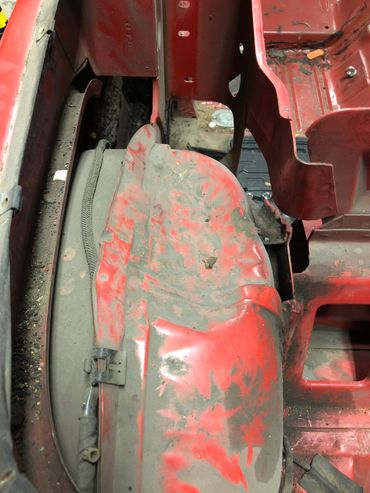Irregularities and Date Coded Parts
(Click on picture to enlarge and see comments)
Radiator support codes

Radiator support codes
Early in the assembly process hand-written codes were applied to the passenger and driver side of the radiator support structure with a paint pencil, which became etched into the metal. Final process painting covered the codes, but careful removal (not sandblasting) allow the codes to once again become visible.
These codes are assembly identifiers and were used to show line location, order and build data instructions. Here are what the codes represent from what we know:
Passenger side
C8 - Skid "C", car #8
76A - Convertible
J6 - Rangoon red exterior, standard black interior
BL - Back-up lights
Driver side
#54 - Unknown
#33 - Build number. Of the handful of pre-production Mustangs, which have had these codes revealed and preserved, this is the lowest number that has been documented.
Rear wheel wells


Rear wheel wells
1964.5 Mustang models consisted of hardtop coupes and convertibles. The very earliest pre-production convertibles used the same rear wheel well sections as the coupes, which caused a clearance problem for the convertible top when in the down and stored position. The temporary solution was to pound the tops of the wheel wells down with large hammer. This was just one of many irregularities to be corrected in the production line learning process. A correctly formed section was created for the mass production convertibles.
Frame cut-outs






Frame cut-outs
The tires on the earliest pre-production units would rub the frame while turning sharply to the right. The temporary fix was to crudely notch out the frame with a torch. The last picture shows the tire fitting into this torched out notch.
Rear differential factory markings




Brake booster mounting
Brake booster mounting
The brake booster mounts to the firewall with four bolts that screw into threaded fittings welded to the backside of the firewall. The bolt pattern on the brake booster did not match up with the location of these threaded fittings, so the left side holes were wobbled out and loose threaded nuts were used on the backside for attachment.
Master cylinder fill cap
Master cylinder fill cap
Pre-production units came with brass fill caps, as shown in the picture above, while the mass production cars had steel caps.
Rear valance
Rear valance
When viewed from the backside the rear valance shows unfinished tooling and sharp edges, which were more refined and rounded in the production units.
Front valance
Front valance
The front valance has these two tabs, located just left and right of the license plate mount, on the very top. The reason for the tabs is unknown and they were eliminated from the mass production units.
Dash cut-out




Dash cut-out
The dash frame, on the drivers side, was cut out with a torch to make room for the instrument panel. Mass production units used a modified frame that would accept the cluster without any interference.
Dash pad support



Dash pad support
The vinyl & foam dash pad mounts to the inner structure via the steel dash pad support bracket. This support bracket is attached to the inner structure with several screws, while the mass production units were spot welded together.